The People of Vietnam: Tài Huỳnh Công
By Anastacia Crowe
 During my stay in Vietnam I met a great deal of people who I came to adore, and even love, but there were few who made such an impression on me. Tai, a malaria survivor, soon-to-be father of three, and nature guide in Cat Tien National Park, was one of those people.
During my stay in Vietnam I met a great deal of people who I came to adore, and even love, but there were few who made such an impression on me. Tai, a malaria survivor, soon-to-be father of three, and nature guide in Cat Tien National Park, was one of those people.
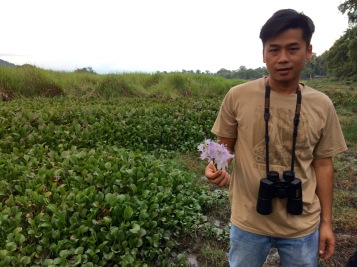 From the moment we hiked in to Crocodile Lake, until the moment that we were dropped back off at Cat Tien National Park Headquarters, Tai was there to watch over us. Throughout our three-day trip to Crocodile Lake, Tai, with his trained eyes was there to point out and name all the birds, primates and other creatures that we wouldn’t have noticed with our untrained eyes.
From the moment we hiked in to Crocodile Lake, until the moment that we were dropped back off at Cat Tien National Park Headquarters, Tai was there to watch over us. Throughout our three-day trip to Crocodile Lake, Tai, with his trained eyes was there to point out and name all the birds, primates and other creatures that we wouldn’t have noticed with our untrained eyes.
 Tai’s job as a nature guide in the jungles of Cat Tien fits his personality remarkably well: He is a man of few words, choosing to observe everything and everyone around him, rather than talking. Without his stoic demeanor, observant eyes, and humble attitude, he wouldn’t be excellent guide that we came to know.
Tai’s job as a nature guide in the jungles of Cat Tien fits his personality remarkably well: He is a man of few words, choosing to observe everything and everyone around him, rather than talking. Without his stoic demeanor, observant eyes, and humble attitude, he wouldn’t be excellent guide that we came to know.
During our trip, I came to realize just how much Tai loved the jungle and the creatures that inhabit it. When we were packing up to leave on our last day at Crocodile Lake, I asked him what led him to spend his life as a nature guide, he simply stated, “The forest”. From the few short days that I spent with Tai, I could tell that his love for nature and wildlife far outweighs his love for people, as he seems to search for solitude outside, rather than choosing to spend time with large groups of people. Who could choose to spend their lives leading people on overnight trips deep into the jungles of Vietnam if they didn’t love the quietness that nature provides in the way that he does.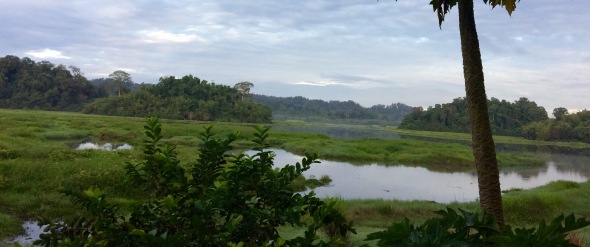
Protecting What Remains
By Shannon James
I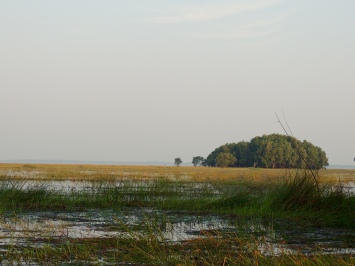 have been staring out the window for a couple of weeks, cruising all around the Southern Mekong River Delta. Coming from Montana, it was striking to be covering so much ground and mainly be looking out on busy streets full of people, shops, and motorbikes. It wasn’t until I reached some of the protected areas of Vietnam that I was able to catch a glimpse of the diverse, natural environment that has been left undeveloped.
have been staring out the window for a couple of weeks, cruising all around the Southern Mekong River Delta. Coming from Montana, it was striking to be covering so much ground and mainly be looking out on busy streets full of people, shops, and motorbikes. It wasn’t until I reached some of the protected areas of Vietnam that I was able to catch a glimpse of the diverse, natural environment that has been left undeveloped.
The National Parks in Vietnam run under a management scope that differs from the United States. Here, the parks require active management. Forests need restoration due to the American destruction from Agent Orange. Climate change impacts present an immediate need for adaptation planning. And water management is a crucial focus.
Th roughout our travels we had the opportunity to visit various National Parks within the Mekong Delta region. U Minh Thuong and Tram Chim are two protected wetland areas that support tremendous biodiversity. We toured through both parks via boat; witnessing expansive grasslands and various bird species. Such diversity, it turns out, depends on intensive water management. Both of the parks were recently established following massive fires. Preventing future fires, as well conserving the rich biodiversity in these areas, requires active management to pump water into the parks during the dry season.
roughout our travels we had the opportunity to visit various National Parks within the Mekong Delta region. U Minh Thuong and Tram Chim are two protected wetland areas that support tremendous biodiversity. We toured through both parks via boat; witnessing expansive grasslands and various bird species. Such diversity, it turns out, depends on intensive water management. Both of the parks were recently established following massive fires. Preventing future fires, as well conserving the rich biodiversity in these areas, requires active management to pump water into the parks during the dry season.
The conservation of these remnant wetlands is not an easy task, one made more difficult by the unraveling consequences of climate change. The seasons are becoming more extre me, resulting in more drought during the dry season and more floods during the wet season. Efforts to deal with the challenges of the changing climate include building dykes and pumping water into the parks from the Mekong Basin. This, however, brings its own challenges as highly polluted water is then pumped into the parks. Unfortunately, while both national parks we visited are monitored for water quality, there are no current practices of cleaning the water of pollutants.
me, resulting in more drought during the dry season and more floods during the wet season. Efforts to deal with the challenges of the changing climate include building dykes and pumping water into the parks from the Mekong Basin. This, however, brings its own challenges as highly polluted water is then pumped into the parks. Unfortunately, while both national parks we visited are monitored for water quality, there are no current practices of cleaning the water of pollutants.
While visiting U Minh Thuong Park we learned about the rare peat swamps that reside in the area. Much of the carbon rich wetlands across the globe have been lost due to land use change for agriculture. Peat swamps are carbon sinks, making them vulnerable to intense burning if they are exposed and dried out.  The peat gives the overlying waters a dark black color, creating quite a contrast with the vibrant green foliage. It was really quite beautiful to witness, making it slightly easier to overlook the insane expansion of invasive species crowding the dark waters.
The peat gives the overlying waters a dark black color, creating quite a contrast with the vibrant green foliage. It was really quite beautiful to witness, making it slightly easier to overlook the insane expansion of invasive species crowding the dark waters.
It is striking to me how essential water management is to sustain what remains of Vietnam’s natural environment.  Those working on preservation face many challenges: financial support for the necessary science, global climate change impacts, invasive plants, overpopulation, and the high dependence of the surrounding communities on resources within parks. On top of all this is the most pressing concern facing the Mekong today, new large-scale dam. Upstream from Vietnam, eleven large dams have been proposed, which would fundamentally alter the flow of water and sustainability of these parks. Breathing in the fresh Maleleuca forest air in Tram Chim is not a luxury of leisure. A large amount of work is put in to protect the parks and continuously manage the valuable wet lands that sustain Vietnam’s natural gems.
Those working on preservation face many challenges: financial support for the necessary science, global climate change impacts, invasive plants, overpopulation, and the high dependence of the surrounding communities on resources within parks. On top of all this is the most pressing concern facing the Mekong today, new large-scale dam. Upstream from Vietnam, eleven large dams have been proposed, which would fundamentally alter the flow of water and sustainability of these parks. Breathing in the fresh Maleleuca forest air in Tram Chim is not a luxury of leisure. A large amount of work is put in to protect the parks and continuously manage the valuable wet lands that sustain Vietnam’s natural gems.
Species Conservation
By Kyla Crisp
 Imagine seeing a flock of white birds flapping their way through the sky. On first thought, you might just assume they are some boring seagulls, especially if you are from the Pacific Northwest. Fortunately, the birds we saw at Tram Chim National Park were anything but ordinary. The diversity ranged from Egrets, Grey Herons, and Cormorants to Kingfishers and Purple Swamphens. However, the elusive symbol of the park, the Sarus Crane, was nowhere to be found. T
Imagine seeing a flock of white birds flapping their way through the sky. On first thought, you might just assume they are some boring seagulls, especially if you are from the Pacific Northwest. Fortunately, the birds we saw at Tram Chim National Park were anything but ordinary. The diversity ranged from Egrets, Grey Herons, and Cormorants to Kingfishers and Purple Swamphens. However, the elusive symbol of the park, the Sarus Crane, was nowhere to be found. T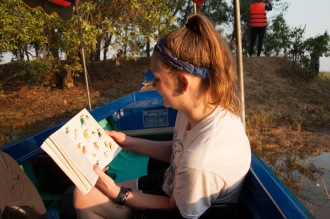 he park is a sanctuary for many of these species. Without protection, the biodiversity of the area will decline.
he park is a sanctuary for many of these species. Without protection, the biodiversity of the area will decline.
While boating through the tunnels of trees watching the birds fly overhead, I understood the meaning of the park’s name. The National Park is appropriately named after its two main inhabitants: Tram, which describes the constant Melaleuca forest, and Chim, the Vietnamese word for bird. Tram Chim National Park is a 7,588 hectare protected ecosystem with the goals of species conservation and wetland preservation. With 130 species of plants, 140 species of invertebrates, 90 species of fish and 130 species of birds, the amount of biodiversity is evident.  Although the park is located inland, near the border with Cambodia, the park is strongly affected by the floodwaters of the Mekong River.
Although the park is located inland, near the border with Cambodia, the park is strongly affected by the floodwaters of the Mekong River.
The park is divided into five separate management zones with dikes and sluice gates providing the equipment for water management in each section. Zone 1, the place we boated through, is focused on sustainable tourism. The other zones have the main goal of ecological restoration. Within the park, there is also a buffer zone, where residents from the surrounding area are able to use the natural resources.
 As we were told by some of the park biologists, these individuals threaten the sustainability of the park as their population and use of resources grow each year. As we spiraled our way up a four story observation tower, the park boundary couldn’t have been clearer. To the left, all I could see was cookie-cutter catfish farms lined up against the horizon.
As we were told by some of the park biologists, these individuals threaten the sustainability of the park as their population and use of resources grow each year. As we spiraled our way up a four story observation tower, the park boundary couldn’t have been clearer. To the left, all I could see was cookie-cutter catfish farms lined up against the horizon.  To the right, however, the greener forests and grasslands of Tram Chim National Park were visible as far as I could see. Seeing this contrast, I could understand how important the park is to protecting the biodiversity of the area.
To the right, however, the greener forests and grasslands of Tram Chim National Park were visible as far as I could see. Seeing this contrast, I could understand how important the park is to protecting the biodiversity of the area.
Our guide for the day was an avid bird watcher. Although it was 70 degrees and sunny, it is winter in Vietnam, and she led us on a quest to find the elusive Sarus Crane wearing her winter clothes and with bird identification book in hand. As the tallest of the flying birds, the Sarus Crane can grow up to a height of 1.8 meters.They live in Vietnam from January to May and spend the rest of their time in Cambodia where they breed with their long-time pair-bond.  Unfortunately, the Sarus Crane is considered a vulnerable/threatened species. This is mainly due to the decrease in their food sources and an overall decline in their world population. The park serves the purpose of protecting the few individuals that are left. Although eight individuals were seen in the park earlier that day, we were unsuccessful in finding them.
Unfortunately, the Sarus Crane is considered a vulnerable/threatened species. This is mainly due to the decrease in their food sources and an overall decline in their world population. The park serves the purpose of protecting the few individuals that are left. Although eight individuals were seen in the park earlier that day, we were unsuccessful in finding them.
Tram Chim National Park is beginning to face some major challenges that will only get worse in the future. Climate change is only one aspect. Both sea level rise and changes in precipitation will lead to flooding in the park and throughout the Mekong Delta. Already, intensive water management is needed to remove water during the flooding season and add water during the dry season.  Dams proposed upstream on the Mekong River present the greatest threat, decreasing water flow in the dry season, leading to increased drought and fire. Invasive plants present another great threat to the park’s biodiversity.
Dams proposed upstream on the Mekong River present the greatest threat, decreasing water flow in the dry season, leading to increased drought and fire. Invasive plants present another great threat to the park’s biodiversity. 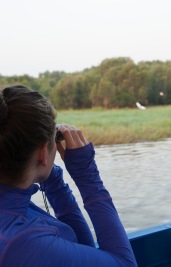 Given these pressures, and with limited funding for research and conservation, Tram Chim National Park might struggle with species conservation in the future.
Given these pressures, and with limited funding for research and conservation, Tram Chim National Park might struggle with species conservation in the future.
Compared to some of the other national parks we visited, Tram Chim actually had other tourists in addition to us. They had a total of 61,000 last year, which is a lot given the challenge necessary to reach the park. The park saw nearly a 150% increase in visitation over the last year, likely due to its declaration as a RAMSAR wetland of international importance. Obviously people want to see the biodiversity of the park and I am glad we endured the long bus and ferry rides in order to reach it.

Motorbikes, Bicycles, Cars, and Boats: Vietnam Transportation 101
By Lauren Miller
 Motorbikes zipping past you, horns honking, and near head on collisions. There are really no words to describe the traffic you encounter in Ho Chi Minh City, Vietnam; it is something you have to experience for yourself. From the moment I got into a taxi to drive us to our first hotel, I was holding my breath. The taxi driver weaved in and out of traffic. The lines on the roads didn’t seem to matter and speed wasn’t a factor. Basically, my first perception of transportation in Vietnam was that there are no rules. Traffic lights exist in bigger cities but are rarely used in rural areas. Motorbikes can drive down the middle of the road and on the sidewalk. To be honest, it was at first absolutely terrifying. However, as I learned to trust our experienced drivers, I saw there were rarely accidents.
Motorbikes zipping past you, horns honking, and near head on collisions. There are really no words to describe the traffic you encounter in Ho Chi Minh City, Vietnam; it is something you have to experience for yourself. From the moment I got into a taxi to drive us to our first hotel, I was holding my breath. The taxi driver weaved in and out of traffic. The lines on the roads didn’t seem to matter and speed wasn’t a factor. Basically, my first perception of transportation in Vietnam was that there are no rules. Traffic lights exist in bigger cities but are rarely used in rural areas. Motorbikes can drive down the middle of the road and on the sidewalk. To be honest, it was at first absolutely terrifying. However, as I learned to trust our experienced drivers, I saw there were rarely accidents.

Check out this short film by Rob Whitworth: http://vimeo.com/32958521
Geography has always been something that has interested me, learning about how people are connected through places, culture, and language.Once I made the decision to study Geography at the University of Montana, I focused on community and environmental planning. With Vietnam’s heavily concentrated population, it is a perfect focus area for seeing how densely populated communities are planned, specifically their roadways and transportation systems. Vietnam is the 13th most populated country in the world, with 92 million people in an area smaller than Montana. Each person has his or her own way of getting around, mostly by motorbike. The roads are crowded, but somehow people are able to communicate with each other in a way that works. In Montana when a traffic light goes out, complete chaos ignites, but not so in Vietnam.
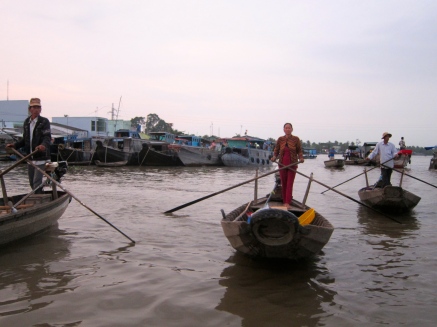 In the Mekong Delta, before roads were built, the rivers formed the first transportation system. Under French colonization a vast canal system was built. The French encouraged travel on these waters, which allowed for easy trade and the export of goods.
In the Mekong Delta, before roads were built, the rivers formed the first transportation system. Under French colonization a vast canal system was built. The French encouraged travel on these waters, which allowed for easy trade and the export of goods.
Today, the livelihoods of many people still depend on the water for boat travel, and many products are transported this way.
For visitors, traveling by boat on the Delta makes for a fun and exciting experience, if you ever get the chance to travel to Vietnam.
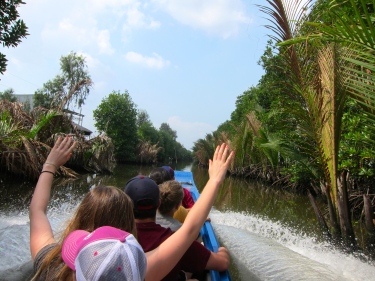 In the United States, as compared to Vietnam, the transportation system was designed for the automobile. The roadways and highway system moves traffic steadily and laws are enforced to keep people safe. Without these laws, more accidents would occur on a daily basis. Roads are also designed so driving doesn’t take much thought: when the light turns green, you go. Driving is designed to extract yourself from the outside world, turn on your favorite tunes, and be alone for your commute. Vietnam, however, has a system completely opposite; and it works. Roads are designed simply, usually two lane roads and four lanes in the bigger cities. People use their horns to communicate with one another, informing the other person they are driving behind them.
In the United States, as compared to Vietnam, the transportation system was designed for the automobile. The roadways and highway system moves traffic steadily and laws are enforced to keep people safe. Without these laws, more accidents would occur on a daily basis. Roads are also designed so driving doesn’t take much thought: when the light turns green, you go. Driving is designed to extract yourself from the outside world, turn on your favorite tunes, and be alone for your commute. Vietnam, however, has a system completely opposite; and it works. Roads are designed simply, usually two lane roads and four lanes in the bigger cities. People use their horns to communicate with one another, informing the other person they are driving behind them.  Eye communication is crucial when crossing busy intersections. Unlike the United States, this system involves a heightened sense of awareness and communication between drivers.
Eye communication is crucial when crossing busy intersections. Unlike the United States, this system involves a heightened sense of awareness and communication between drivers.
Looking into the future, Vietnam will see a rise in automobile traffic as taxes are lowered (now at 300%) and more people will be able to afford their own vehicle. What will Vietnam look like with more cars than motorbikes on the road? Cities will be even more congested and I believe more accidents will occur.  The lack of parking infrastructure is already an issue and the space is very limited as to where more can be added. Cities will become even more polluted and Vietnam’s CO2 emissions will rise significantly.
The lack of parking infrastructure is already an issue and the space is very limited as to where more can be added. Cities will become even more polluted and Vietnam’s CO2 emissions will rise significantly.
Vietnam is a beautiful country, full of life, and traveling around is an experience all in its own. If you ever travel to Vietnam, riding on the back of a motorbike is one of the most fun and exhilarating experiences and immerses you in to the hustle and bustle of the cities, something you can not experience anywhere else.
Shrimp Eggs
By Shanti Johnson
The creature’s eyes stared blankly up at me from my plate. I stared back, taking in the curling antennas and the bulging, purplish-grey egg sack clutched between its legs. I could feel my Vietnamese host-mom watching me.
Normally, I like eating shrimp. Well, I like eating shrimp tails, cleanly separated from their eggs and eyes so as to make for a secular eating experience. Back home in Montana, I rarely ever eat fish or meat and prefer a mostly vegetarian diet. But I wasn’t sitting in Montana; I was sitting in an open-air restaurant, half a world away, in Vietnam, where shrimp eggs, eyes and brains are all part of the eating experience.
I picked up the steaming creature and began peeling away the thin shell—the only thing separating me from my newest cultural eating experience. As I worked away at the exterior, I wondered about where my shrimp had come from.
Shrimp are everywhere in the Mekong Delta of Vietnam. They appear in big ponds across the landscape where they are being farmed; they are show up alive and squirming in buckets at the market; and they show up in soups, spring rolls and dried mounds in restaurants. The tasty crustaceans fetch a much higher price at market than rice, causing many land-owners to convert some—or all—of their land to aquaculture (which is the farming of shrimp, fish and crabs).
Like most other kinds of rapid industrialization, the boom in aquaculture has brought with it a variety of environmental problems. For instance, in order to gain a maximum yield, farmers will often dump excess amounts of feed into their stock ponds. Farmers will also use antibiotics to ensure their shrimp and fish stay disease-free until they make it to market. The creatures can’t consume all of the food and antibiotics being thrown at them, so the excess ends up washing downstream and into local water sources.
The effects from this water contamination can easily be seen on Son Island, near the city of Can Tho. On Son there has been a major increase in catfish farming and both ends of the small island (the perimeter is only about six kilometers) have been converted into stock ponds. The island lacks an adequate water treatment facility and the excess nutrients washing out of the ponds pollute the local water and make it undrinkable for residents.

Rice, shrimp combo
Problems with aquaculture, such as the water pollution, have not gone unnoticed. Several sustainability-conscious researchers are pioneering new ways to decrease environmental pollution, while still protecting people’s livelihoods.

Rice, aqua combo
One solution promoted by researchers at Can Tho University is to combine rice and aquaculture farms. In this model, ponds holding crabs, fish and shrimp are maintained alongside plots of rice. The technique is symbiotic in that the rice and shrimp support each other. The shrimp help fertilize the rice and the rice helps filter the shrimp-polluted water before it leaves the farm. Additionally, farmers cannot apply pesticides or fertilizers to the rice, for fear of killing the shrimp. They must also be conscious of how much food or antibiotics they give the shrimp, for fear of harming the rice crop. The combination naturally lends itself to a more environmentally friendly outcome.
A second solution, that addresses both pollution and land-use by farmers, focuses on raising shrimp in natural mangrove habitats. In parts of Cape Ca Mau National Park, farmers are allowed to develop and cultivate 30 percent of their one-hectare land plots. Many farmers within the park are choosing to use the mangrove forests to naturally cultivate shrimp. Much like the rice/shrimp model, the relationship with the mangroves is mutually beneficial. Leaf litter from young mangroves serves as a natural food source for the shrimp, and farmers are not allowed to use artificial fertilizers, feed or antibiotics within the park, in order to protect the mangroves. Though not all farmers adhere to the rules, overall the solution seems to be working well and is helping support local and environmentally sustainable livelihoods within the park.
The next step in supporting these livelihoods is to begin marketing the shrimp as sustainably-raised and eco-friendly. Educating consumers about where their food comes from is critical to keep the environmentally-friendly industry going. As a consumer, I take my power of choice very seriously, purchasing sustainable, organic products whenever possible.

Selling shrimp
My thoughts brought me back to my pregnant shrimp. I wondered if she had come from an eco-friendly farm, or one of the more intensive shrimp farms. As great as the eco-friendly models might be, the number of shrimp per harvest is lower than what an industrial farm outputs. Intensive farming is one way Vietnam can continue to bolster its economy while also meeting local and international demand for its products, like my shrimp.
I was almost done peeling away the shell and was nearing the inevitable. It was time to take a bite. I went for the eggs first, to get it over with. I pushed my psychological chatter aside, my weariness to indulge in food with unknown origins. I tried to embrace what was in front of me.
The purplish-grey paste hit my tongue.
“It’s good, yes?” My host-mom asked, beaming.
I mulled the eggs around my mouth. Smiling, I and turned to my generous host and said, “Actually, it’s delicious.”
Can Tho Floating Market: A Community of Food
By Cassandra Kritikos
 Before the sun had stretched its rays across the horizon, our group was aboard a long boat headed towards the Can Tho floating market. At just past five o’clock in the morning, all of us were tired, and many dozed off as we made our way across the river, the boat splashing against the waves. Too dark to see far ahead, we scanned our visible horizon for any sign of market activity, eagerly awaiting the soon-to-be-seen community drifting in the river. After what seemed like ten-or-so minutes we arrived at our destination, the floating market only populated by a meager fraction of what was to come.
Before the sun had stretched its rays across the horizon, our group was aboard a long boat headed towards the Can Tho floating market. At just past five o’clock in the morning, all of us were tired, and many dozed off as we made our way across the river, the boat splashing against the waves. Too dark to see far ahead, we scanned our visible horizon for any sign of market activity, eagerly awaiting the soon-to-be-seen community drifting in the river. After what seemed like ten-or-so minutes we arrived at our destination, the floating market only populated by a meager fraction of what was to come.
With each passing minute the sky seemed to brighten ever so slightly, allowing us to take in more and more of our surroundings. Almost like clockwork, additional boat-vendors began to drift in, crowding the floating market district. Vendors sold many varieties of fruit, from mango to pineapple, coffees and drinks and even had hot woks and grills ready to cook fresh food for customers.  We snacked on bananas and mango while sipping our strong Vietnamese coffees laced with not nearly enough condensed milk. As a new boat would drift into the market grounds, a subconscious connection between other vendors was necessary to successfully guide their boats into the small spaces between the floating shops. Despite the early hour and still hidden sun, smiles were seen stretched across every passing face. The history between boat vendors was evident – years of selling their goods at this market had engrained strong relationships between merchants.
We snacked on bananas and mango while sipping our strong Vietnamese coffees laced with not nearly enough condensed milk. As a new boat would drift into the market grounds, a subconscious connection between other vendors was necessary to successfully guide their boats into the small spaces between the floating shops. Despite the early hour and still hidden sun, smiles were seen stretched across every passing face. The history between boat vendors was evident – years of selling their goods at this market had engrained strong relationships between merchants.
The beauty of the market is its history, one drawn from a time before cars where Vietnamese traveled by boats down the Mekong River. Each major city in the Mekong Delta is separated by roughly 60 km, a distance traveled in a few hours with a downstream current.  The location of the market, as explained by our teaching assistant Duyen is a historic stop made during one’s travels down the river. The market has been around for years, and despite the large amount of tourism in the region and Vietnam as a whole, the market seemed largely untouched by tourist activity. Dinh, another teaching assistant to our program, explained to me that the market is often the sole form of income for the vendors, who boat from many parts of the province through distributaries connecting to the Mekong River. This intrinsic part of Vietnamese culture is just for the locals, and those lucky enough to venture down the river at the crack of dawn.
The location of the market, as explained by our teaching assistant Duyen is a historic stop made during one’s travels down the river. The market has been around for years, and despite the large amount of tourism in the region and Vietnam as a whole, the market seemed largely untouched by tourist activity. Dinh, another teaching assistant to our program, explained to me that the market is often the sole form of income for the vendors, who boat from many parts of the province through distributaries connecting to the Mekong River. This intrinsic part of Vietnamese culture is just for the locals, and those lucky enough to venture down the river at the crack of dawn.
Food, culture and community are synonymous—each culture possesses a unique dichotomy of food, one that brings together every corner of the patchwork-quilt that is life to form community. Food has always been an important aspect of my life, helping me grow in my friendships, my life and show my love to others in an indirect manner.  From the way my grandmother would feed me until I was close to bursting, or from the communal dishes spread across the dining table as my friends and I feasted on delicacies while enjoying each other’s company. The ability of food to both express the subtleties of one’s culture while also bringing people together is remarkable, and a common denominator found in all cultures across the world. My excitement to experience the floating market hovered around this central idea of community and culture, the market an outlet of Can Tho to express a deep engrained piece of cultural identity that has embedded itself within the community for ages, just as the taste of sweet Vietnamese coffee sticks to your tongue.
From the way my grandmother would feed me until I was close to bursting, or from the communal dishes spread across the dining table as my friends and I feasted on delicacies while enjoying each other’s company. The ability of food to both express the subtleties of one’s culture while also bringing people together is remarkable, and a common denominator found in all cultures across the world. My excitement to experience the floating market hovered around this central idea of community and culture, the market an outlet of Can Tho to express a deep engrained piece of cultural identity that has embedded itself within the community for ages, just as the taste of sweet Vietnamese coffee sticks to your tongue.
While our time at the market was short, the energy felt and connections seen stretched far beyond our short stay. As we rocked in our boat observing the market activity, sounds of traditional Vietnamese river music echoed in our ears as water lapped against the hull of the boat. We pointed the bow of our boat in the direction of our guesthouse and headed towards our temporary home, sailing past floating fields of vivid green water hyacinth plants rising and falling in the waves produced by our speeding boat.
 As the sun rose above the horizon and stretched its arms across the sky, our tired eyes finally opened wide with our stomachs full of delicious fruit as we reflected on our experience. Each boat in the market was a swath of new food and goods to shop from; each boat a home and business to a Vietnamese; each boat interconnected to form a community, a community of food floating in the Mekong Delta.
As the sun rose above the horizon and stretched its arms across the sky, our tired eyes finally opened wide with our stomachs full of delicious fruit as we reflected on our experience. Each boat in the market was a swath of new food and goods to shop from; each boat a home and business to a Vietnamese; each boat interconnected to form a community, a community of food floating in the Mekong Delta.
Feeling at Home
By Sam Cheney
I was anxious leading up to the taxi ride away from our cozy hotel to unknown location for a three day homestay. I didn’t know the people taking us home with them, I wasn’t sure if they were going to like me, or if I would offend them somehow with a rude gesture. When Thai, my host sister, arrived at the hotel, she was so perfectly nice and she spoke fluent English; I really didn’t expect that.
 Expectations are funny things that can often lead to people jumping to conclusions or being upset when something doesn’t go their way. But it can also lead to new experiences and surprises that can take people somewhere they never expected.
Expectations are funny things that can often lead to people jumping to conclusions or being upset when something doesn’t go their way. But it can also lead to new experiences and surprises that can take people somewhere they never expected.
“I never expected for my host family to have so much,” said Lauren, whom I shared a host family with. She went on to say that she didn’t know that they would have such a nice home. She also thought that they would have many different cultural practices that we would also have to take part in, but neither of us noticed those kinds of things.
 When I got to my host family’s home, Thai led me through a gate where I would expect to find a front door, but I found out later this area was to accompany the family’s motorbikes because they can’t leave them outside and there is no garage. Their house had very high ceilings and banana trees in the back. They also had a pet rooster who crowed once every half hour.
When I got to my host family’s home, Thai led me through a gate where I would expect to find a front door, but I found out later this area was to accompany the family’s motorbikes because they can’t leave them outside and there is no garage. Their house had very high ceilings and banana trees in the back. They also had a pet rooster who crowed once every half hour.
Thai is a 22 year-old pharmacy student who spoke to us in fluent English. From the moment she picked us up she had such an enthusiasm about knowing about us and our culture. She lives with her parents who work at Can Tho University as accountants. Then she has a little sister, 9, and a cousin, 19, who was also going to the university. Her 80 year grandmother lived in the house as well. We would also see an 8 year old boy, who looked in our room occasionally who turned out to be their cousin.
“I ate a rat.” Cassie said, who lived in a different house but had many of the same experiences as Lauren and me except for that one.  “I definitely tried it,” she shared. I think that is really all she wanted to say about it, and that she and her roommate Hannah overall enjoyed the cooking at their homestay.
“I definitely tried it,” she shared. I think that is really all she wanted to say about it, and that she and her roommate Hannah overall enjoyed the cooking at their homestay.
Everyone’s food experiences were different. Some people got to go out to eat with their host families while others were made more traditional Vietnamese food at home. Our host family made us what we thought was similar to American food while incorporating a lot of fruits from Vietnam. On the first day Thai asked us what kinds of food we had liked while we had been in Vietnam and she also asked about what kinds of fruits we liked back home. Lauren and I both agreed it was apples. While staying at the homestay we were provided with both our favorite Vietnamese dish, Pho and apples. They definitely tried to help us feel at home.
The time that Lauren and I were there, we always felt like they wanted us to be there. They wanted to see photographs and hear us speak English. The younger children wanted us to help them with their homework and they tried, somewhat successfully, to teach us their way of playing dominoes.
 “It was nice to see the family dynamic and that they are all just people. It’s nice to see that stuff crosses over cultures,” said Kelsey, who roomed with Kyla. They stayed with an older married couple who had adult children, but they still enjoyed poking fun at one another for being bossy. “You could tell they really loved each other,” Kelsie shared.
“It was nice to see the family dynamic and that they are all just people. It’s nice to see that stuff crosses over cultures,” said Kelsey, who roomed with Kyla. They stayed with an older married couple who had adult children, but they still enjoyed poking fun at one another for being bossy. “You could tell they really loved each other,” Kelsie shared.
It was nice to see that so many students, including myself, really enjoyed the experience of being with a family. There is something about being in a country and getting to experience their norms, their large family, their hospitality and sometimes the strange quirks that come with every family. I thank Thai and her family so much for taking us in for a few days.
As Lauren and I were whisked away by Thai and her best friend on the back of a motorbike for the first and last time during our homestay, we weren’t anxious at all. We felt right at home.
Ethnic Diversity in Vietnam, Khmer Traditions in line with the Bat Pagoda
By Henry Lilly
 Vietnam is a place of variety, to say the least. This can be said about the food, geography, traditions, culture, and ethnic groups of the country. During our time in Vietnam, we have been able to have a first hand look at a number of different ethnic groups of Vietnam through discussions of history, culture, and the arts and by visiting some local pagodas, which was quite different than I expected. One thing that I have learned during this trip is that surprises are around every corner in Vietnam, from the people you meet to the places that you visit.
Vietnam is a place of variety, to say the least. This can be said about the food, geography, traditions, culture, and ethnic groups of the country. During our time in Vietnam, we have been able to have a first hand look at a number of different ethnic groups of Vietnam through discussions of history, culture, and the arts and by visiting some local pagodas, which was quite different than I expected. One thing that I have learned during this trip is that surprises are around every corner in Vietnam, from the people you meet to the places that you visit.
With an ever growing population that is closing in on 90 million people, Vietnam has 54 different ethnic groups. These groups differ in belief, tradition, customs, and much more. During many of our lectures, the speakers have focused on the main groups of southern Vietnam, which are Khmer, Champa, Funan, Chinese, and Vietnamese.  These four groups have been known throughout the centuries to have the longest lineage in Vietnam, but differ in many aspects, especially in religion as well as music. Two of the main groups that differ are the Vietnamese, or Kinh, and the Khmer. Within the religion both the Khmer and Kinh have Buddhist roots but worship two different gods. The Khmer worship the god Therauada, while the Vietnamese worship the god Mahayama. When visiting the Khmer pagodas I found that the monks also wear yellow robes while the Vietnamese monks dress in different colored attire. These are only a few of the differences between these two different ethnic groups. As a group, we were able to visit and focus on the Khmer religion and look more in depth onto the ideology and traditions of the Khmer people.
These four groups have been known throughout the centuries to have the longest lineage in Vietnam, but differ in many aspects, especially in religion as well as music. Two of the main groups that differ are the Vietnamese, or Kinh, and the Khmer. Within the religion both the Khmer and Kinh have Buddhist roots but worship two different gods. The Khmer worship the god Therauada, while the Vietnamese worship the god Mahayama. When visiting the Khmer pagodas I found that the monks also wear yellow robes while the Vietnamese monks dress in different colored attire. These are only a few of the differences between these two different ethnic groups. As a group, we were able to visit and focus on the Khmer religion and look more in depth onto the ideology and traditions of the Khmer people.
My first introduction to the Khmer lifestyle and religion was through a lecture on the overall aspects of the cultures of Vietnam. From this we learned about the music and traditions of the Khmer culture. During our le cture, we were graced with the presents of Khmer musicians who played traditional songs as example of their culture. It was honestly one of the highlights of my experience so far. The talent of these so called “amateur” musicians was impressive and gave me a wonderful impression of how artistic and musical their lifestyle and culture really is.
cture, we were graced with the presents of Khmer musicians who played traditional songs as example of their culture. It was honestly one of the highlights of my experience so far. The talent of these so called “amateur” musicians was impressive and gave me a wonderful impression of how artistic and musical their lifestyle and culture really is.  My second impression of the Khmer culture was during our experience at the Phu Tan Commune in the Soc Trang Province.
My second impression of the Khmer culture was during our experience at the Phu Tan Commune in the Soc Trang Province.
The Phu Tan Commune is a low income area that has the chance to participate in a Heifer international Program. We toured throughout the community and learned about how the projects had effected the families and the area’s economic development. These projects have made a large scale difference within the community. 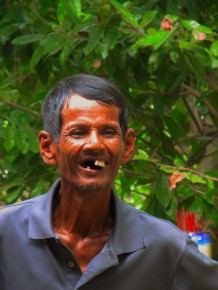 The Khmer community as a whole seemed extremely united. With women’s groups, as well as a community meeting area and committee, it seemed that togetherness as a community was a major priority among the Khmer people.
The Khmer community as a whole seemed extremely united. With women’s groups, as well as a community meeting area and committee, it seemed that togetherness as a community was a major priority among the Khmer people. 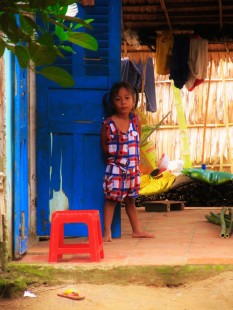 When visiting with the community members I noticed a sheer sense of happiness among them. Even though they had little in material goods, they lived as if they were wealthy in a sense of community belonging. As a complete outsider to this culture, I found this to be extremely profound, especially as they opened their doors to us. Finally, my third glimpse of Khmer culture was found during our visit to the bat pagoda.
When visiting with the community members I noticed a sheer sense of happiness among them. Even though they had little in material goods, they lived as if they were wealthy in a sense of community belonging. As a complete outsider to this culture, I found this to be extremely profound, especially as they opened their doors to us. Finally, my third glimpse of Khmer culture was found during our visit to the bat pagoda.
At first thought, I believed that the Bat Pagoda was a place of worship to bats, however, this thought was changed immediately as we listened to the lectures by the local conservationists.  The Khmer Bat Pagoda is a Buddhist temple of worship that also doubles as a sanctuary for the bats of the area. These bats are important because they are listed upon IUCN Red List of endangered animals in Vietnam. The ones that are mainly at the pagoda are large and small flying foxes. These bats are also considered a hot commodity in Vietnam; each sells for almost five times the price of a chicken on the food market. However, these bats are very important to the Khmer religion and culture. Through acts by Can Tho University, there has been a large movement to save the bats of the pagoda. Saving the bats helps to save the Khmer Culture. When visiting we were able to meet with many advocates of bat protection, ranging from professors to grade school children. This was one of the most surprising moments of the trip. I had no idea that there would be three foot long bats hanging within the trees above the pagoda. It was extremely surprising and interesting, and it was also inspiring.
The Khmer Bat Pagoda is a Buddhist temple of worship that also doubles as a sanctuary for the bats of the area. These bats are important because they are listed upon IUCN Red List of endangered animals in Vietnam. The ones that are mainly at the pagoda are large and small flying foxes. These bats are also considered a hot commodity in Vietnam; each sells for almost five times the price of a chicken on the food market. However, these bats are very important to the Khmer religion and culture. Through acts by Can Tho University, there has been a large movement to save the bats of the pagoda. Saving the bats helps to save the Khmer Culture. When visiting we were able to meet with many advocates of bat protection, ranging from professors to grade school children. This was one of the most surprising moments of the trip. I had no idea that there would be three foot long bats hanging within the trees above the pagoda. It was extremely surprising and interesting, and it was also inspiring.  The idea of promoting conservation from the professional level to grade schools is aggressive measure, and was accomplished by the foresight of members of Can Tho University and in particular Mr. Dang, who is himself Khmer and grew up visiting and studying at this Bat Pagoda.
The idea of promoting conservation from the professional level to grade schools is aggressive measure, and was accomplished by the foresight of members of Can Tho University and in particular Mr. Dang, who is himself Khmer and grew up visiting and studying at this Bat Pagoda.
The Khmer culture and religion is an extremely interesting and impressive. With deep and symbolic roots in music and the arts, Khmer traditions run deep among its people. This can be said for most of the ethnic groups of Vietnam. I personally have been greatly influenced by the cultures, traditions and people of these ethnic groups and have found this part of our studies in Vietnam to be one of the most important in my overall experience.
Modern Poverty
By Hannah Tibke
 Throughout my travels in the enchanting country of Vietnam, a definite constant is the people’s fascination with Americans. No matter where we go, people look, especially the children. When traveling in the Phu Tan commune, Soc Trang Province we had a crowd of children watching us, their eyes alight with curiosity. When asked for a picture, the children would smile big, waiting expectantly. The children here are fearless. They will jump onto a motor scooter, run across a monkey bridge, and explore and play on their own at a very young age. The monkey bridges are pieces of wood tied together with twine and lead unsteadily across a river. The children are so comfortable in their own little world. I saw a child of around eight years old biking around his little sister that was only one year old.
Throughout my travels in the enchanting country of Vietnam, a definite constant is the people’s fascination with Americans. No matter where we go, people look, especially the children. When traveling in the Phu Tan commune, Soc Trang Province we had a crowd of children watching us, their eyes alight with curiosity. When asked for a picture, the children would smile big, waiting expectantly. The children here are fearless. They will jump onto a motor scooter, run across a monkey bridge, and explore and play on their own at a very young age. The monkey bridges are pieces of wood tied together with twine and lead unsteadily across a river. The children are so comfortable in their own little world. I saw a child of around eight years old biking around his little sister that was only one year old.  The brother cared for his sister in way that seemed as if he had cared for her every day since she was born. The children in these small villages grow up unsheltered from the world.
The brother cared for his sister in way that seemed as if he had cared for her every day since she was born. The children in these small villages grow up unsheltered from the world.
The once impoverished village in Soc Trang where the children live has the International Heifer program helping the townspeople develop a steady income and food supply. The Heifer program builds up poverty-stricken communities by giving them livestock The village of Phu Tan is only an hour outside of Can Tho, yet there is a whole new cultural background and language. The Khmer people live in this village and speak their own language.  We needed translators that spoke English, Vietnamese and Khmer. The Khmer live a life of simplicity and opened up their homes to show us their crops, how they make rice, how to weave baskets and showed us their cattle. When a new cow is born, it is given to another family in need somewhere in the community. Getting the chance to visit this community and see how Heifer International has helped them was a humbling experience that won’t be forgotten.
We needed translators that spoke English, Vietnamese and Khmer. The Khmer live a life of simplicity and opened up their homes to show us their crops, how they make rice, how to weave baskets and showed us their cattle. When a new cow is born, it is given to another family in need somewhere in the community. Getting the chance to visit this community and see how Heifer International has helped them was a humbling experience that won’t be forgotten.
 The locals have a way of work that almost mimic an art. When beating the rice, the women do so in a steady beat without falter. The beating sounds like music. When cutting the potatoes out of the bushels there is a tedious pattern and skill that has been passed down through the generations. The sound of the bamboo swaying in the wind even sounds like music that would be equivalent to the patter of rain on a roof. The culture in the small village is rich and the traditions strong.
The locals have a way of work that almost mimic an art. When beating the rice, the women do so in a steady beat without falter. The beating sounds like music. When cutting the potatoes out of the bushels there is a tedious pattern and skill that has been passed down through the generations. The sound of the bamboo swaying in the wind even sounds like music that would be equivalent to the patter of rain on a roof. The culture in the small village is rich and the traditions strong.  It is intriguing that such a timeless village with such a rich culture has a modern convenience of a TV. A one bedroomed shack will have a TV, if not anything else. The modern world has certainly reached many parts of the world in ways I would not have expected. Out of all the wonderful, helpful technologies there are in the world, the TV seems the most widespread. When visiting these homes I happened to glance over and see that Reese Witherspoon was on the TV. Perhaps the fascination with the Americans is correlated with the spread of the TV.
It is intriguing that such a timeless village with such a rich culture has a modern convenience of a TV. A one bedroomed shack will have a TV, if not anything else. The modern world has certainly reached many parts of the world in ways I would not have expected. Out of all the wonderful, helpful technologies there are in the world, the TV seems the most widespread. When visiting these homes I happened to glance over and see that Reese Witherspoon was on the TV. Perhaps the fascination with the Americans is correlated with the spread of the TV.
After the War: Healing Land and People
By Mara Menahan
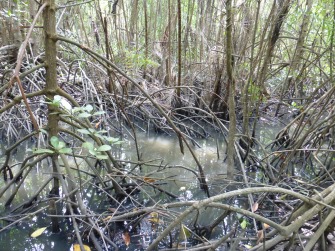 This story is a happy one. It’s a story about local people, regeneration and hope. But first, I want to remind you of a tragic past. In 1961, American troops in Vietnam unleashed the toxic chemical in the sunny skies of the Mekong Delta. The goal of Operation Ranch Hand (the codename for the attack) was to force a mass migration of peasants from their rice paddies and fruit orchards to pro-American cities. With the countryside cleared of people, the Americans prayed that the Viet Cong would be starved of their supporters. Between 1961 and 1971, planes and helicopters dropped a total of 20 million gallons of Agent Orange at a dose 13 times higher than what the U.S. Environmental Protection Agency recommends. The use of the American-made chemical in Vietnam was a warcrime, not just for the cost to human lives, but for the cost to all life. Some call it for what it is–ecocide.
This story is a happy one. It’s a story about local people, regeneration and hope. But first, I want to remind you of a tragic past. In 1961, American troops in Vietnam unleashed the toxic chemical in the sunny skies of the Mekong Delta. The goal of Operation Ranch Hand (the codename for the attack) was to force a mass migration of peasants from their rice paddies and fruit orchards to pro-American cities. With the countryside cleared of people, the Americans prayed that the Viet Cong would be starved of their supporters. Between 1961 and 1971, planes and helicopters dropped a total of 20 million gallons of Agent Orange at a dose 13 times higher than what the U.S. Environmental Protection Agency recommends. The use of the American-made chemical in Vietnam was a warcrime, not just for the cost to human lives, but for the cost to all life. Some call it for what it is–ecocide.
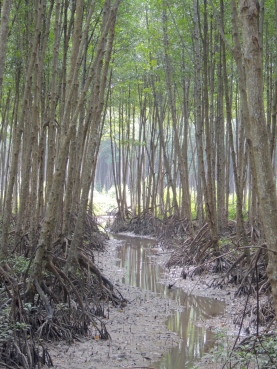 To an American, the destruction of the mangrove forests in the Mekong delta would be like bombing the Redwoods after destroying California’s food-crops. Like the Redwoods, these forests are vital to ecosystem health. If the Redwoods are like lungs, sending sweet oxygen into the air, then mangroves are like kidneys, filtering out toxins and restoring aquatic health. Today, they are even more important since they are helping t
To an American, the destruction of the mangrove forests in the Mekong delta would be like bombing the Redwoods after destroying California’s food-crops. Like the Redwoods, these forests are vital to ecosystem health. If the Redwoods are like lungs, sending sweet oxygen into the air, then mangroves are like kidneys, filtering out toxins and restoring aquatic health. Today, they are even more important since they are helping t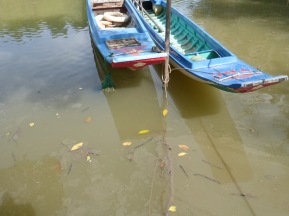 o keep the rising sea at bay, preventing catastrophic flooding and coastal erosion as the climate warms.
o keep the rising sea at bay, preventing catastrophic flooding and coastal erosion as the climate warms.
The only way to experience the mangroves is by boat. Soon after we arrived, we loaded onto a wooden boat with a loud diesel engine. The boat putted down the Long Tau River, passing houses on stilts and shrimp nets. I would never have seen the canal, except that a long narrow boat shot out of the dense foliage. To get a closer look at the mangroves, we needed a smaller boat. We were guided by a shrimp farmer. His boat could only take a few at a time. The first group of students sat cross legged in the bottom of the tiny boat, clinging to the edges white knuckled as the shrimp farmer plunged the motor into the water with a smirk and a wave. As I waited for my turn, watching a kingfisher swoop across the murky water and mudskippers dip into their underground nests, it was hard to believe this area was a no-man’s-land just thirty years ago.
The southern tip of Vietnam is all river. Thick, full silty rivers rimmed with fan palm, coconut trees and mangroves. The nine branches of the Mekong braid across the flat landscape. Swamps, sloughs and canals fill the space in between. Like everything else in the region–the houses, the rice paddies, the markets–the forest also floats. 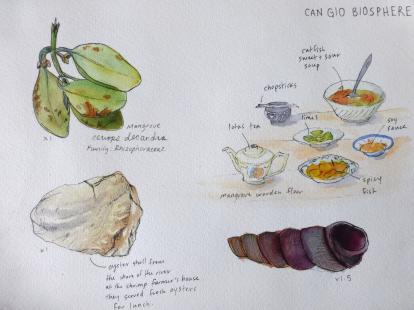 Mangroves adapted to the dynamic waters of coastlines. They specialize in changing salinity and water levels. Their roots thrust deep into the mud, holding up the trunk and the lush branches high above the tides. There are more than forty mangrove species in Vietnam. Interlocking roots trap sediments and without the trees, Vietnam’s coastline would slowly erode.
Mangroves adapted to the dynamic waters of coastlines. They specialize in changing salinity and water levels. Their roots thrust deep into the mud, holding up the trunk and the lush branches high above the tides. There are more than forty mangrove species in Vietnam. Interlocking roots trap sediments and without the trees, Vietnam’s coastline would slowly erode.
When we arrived at a house deep in the Can Gio reserve, I was a little surprised. I’m not used to seeing people living in designated wild places, but here in Vietnam, this is the way conservation gets done. The shrimp farmer lives in a house on stilts, surrounded by water and mangroves on all sides. He uses a small dam to grow shrimp among the mangroves. The 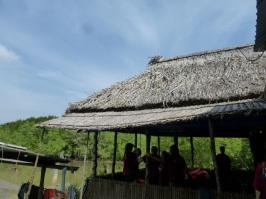 forest provides both food and habitat for the shrimp, and the shrimp acts like fertilizer for the mangroves. Dr. Be explained that this “integrated livelihood system” allows for people to continue to make a living while pursuing conservation goals. Over a meal of catfish, fresh vegetables and rice, we learned that not only is he a shrimp farmer, but he is also a forest guardian. The shrimp farmer earns a bit of income for protecting his part of the mangrove forest from timber harvesters by reporting to local authorities.
forest provides both food and habitat for the shrimp, and the shrimp acts like fertilizer for the mangroves. Dr. Be explained that this “integrated livelihood system” allows for people to continue to make a living while pursuing conservation goals. Over a meal of catfish, fresh vegetables and rice, we learned that not only is he a shrimp farmer, but he is also a forest guardian. The shrimp farmer earns a bit of income for protecting his part of the mangrove forest from timber harvesters by reporting to local authorities.
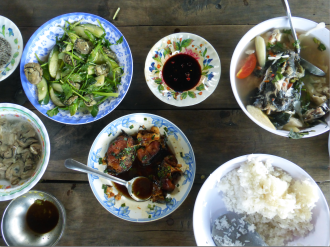 After our meal, we retraced our path down the canal through a tunnel of mangroves, back on the boat and eventually, the bus. We drove a few kilometers further down the road we had taken earlier that day, to a sweeping mudflat. I could see now what the area looked like before the restoration work. We pulled on rubber boots and tromped out into the open field, into the sucking mud, carrying shovels and mangrove seedlings. We passed mangroves that had already been planted, but most of them were less than four feet tall. Our seedlings were about t
After our meal, we retraced our path down the canal through a tunnel of mangroves, back on the boat and eventually, the bus. We drove a few kilometers further down the road we had taken earlier that day, to a sweeping mudflat. I could see now what the area looked like before the restoration work. We pulled on rubber boots and tromped out into the open field, into the sucking mud, carrying shovels and mangrove seedlings. We passed mangroves that had already been planted, but most of them were less than four feet tall. Our seedlings were about t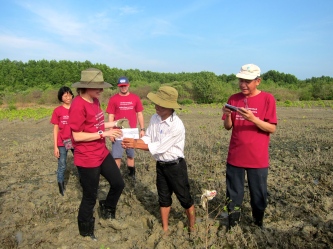 wo feet tall with a single stem and a few clusters of leaves branched on top. We waded our way into the mangrove planting zone. Dr. Be showed us how to squeeze the sapling out of its plastic wrapper at the roots, and dig a five inch hole. I dug my hole with my bare hands, wanting to experience that strange black mud with each one of my senses. After we’d each planted five seedlings, we stood smiling, covered in mud. We shook hands and posed for pictures. Dr. Be awarded us each a certificate. It felt silly, but there really is something ceremonious about restoration work. Healing people, healing land. To me, it felt like some small token of apology for the ecocide my country inflicted. Collectively we planted 65 mangrove trees, a small step in recovering what was lost.
wo feet tall with a single stem and a few clusters of leaves branched on top. We waded our way into the mangrove planting zone. Dr. Be showed us how to squeeze the sapling out of its plastic wrapper at the roots, and dig a five inch hole. I dug my hole with my bare hands, wanting to experience that strange black mud with each one of my senses. After we’d each planted five seedlings, we stood smiling, covered in mud. We shook hands and posed for pictures. Dr. Be awarded us each a certificate. It felt silly, but there really is something ceremonious about restoration work. Healing people, healing land. To me, it felt like some small token of apology for the ecocide my country inflicted. Collectively we planted 65 mangrove trees, a small step in recovering what was lost.
越南 | Việt Nam | Vietnam
By Henry Ho
越南
Việt Nam
Vietnam
 While visiting Vietnam for one week, I have experienced two worlds. What does this mean? Given the short time, I have observed a society integrated with deep eastern cultural roots while at the same time living a modern world with western influences. How can this be possible? This query is particular interesting to me as a young man of Asian descent having grown up in the United States.
While visiting Vietnam for one week, I have experienced two worlds. What does this mean? Given the short time, I have observed a society integrated with deep eastern cultural roots while at the same time living a modern world with western influences. How can this be possible? This query is particular interesting to me as a young man of Asian descent having grown up in the United States.
The name Vietnam in Chinese means “the people of the south.” Viet, or 越, means the people racially non-han or Vietnamese while Nam, or南, means south. Vietnam has been an area of interest by many countries over many centuries allowing for the integration of a complex society. For instance, for over a thousand years Vietnam was ruled by a series of Chinese dynasties, beginning with the expansion of the Han that led to the integration of a complex Confucianism societal dictation. The French colonized Vietnam from 1958-1945, leading to modernization and reformation such as the Romanization of the Vietnamese writing system. The Communist Government led by Ho Chi Minh, reunified the country after a ten year war with the United States. Given the complex historical background of Vietnam influenced from China, France, and the United States, when one  travels to Vietnam to experience the culture, it is a mixture of Asian and Western influence, a combination which has developed uniquely and elegantly for over thousands of years.
travels to Vietnam to experience the culture, it is a mixture of Asian and Western influence, a combination which has developed uniquely and elegantly for over thousands of years.
While living in the United States I never really thought about the Vietnamese culture, even though my parents lived in Vietnam before coming to the States, and even though occasionally I would enjoy the classical foods prepared at home (such as Phò). I always though of it as my normal diet. I normally would not consider the recipe as “Asian,” “Vietnamese,” or “Chinese” used thousands of years ago from a far away land that I never visited. Now, visiting here for three short weeks, I have given more thought about my roots and the distinctive nature of Asian culture. For example, what we eat, how the people are dressed, the way people act, and the essence of time itself is so different, perhaps one could say uniquely culturally Asian, and yet very Western influenced. In essence, the Vietnamese are distinctly unique compared to the rest of Asia. Over the course of a thousand years of Chinese rule, the Vietnamese borrowed words and phrases from the Chinese and developed a tonal structured language; one word may have multiple meanings. More recently, during French colonization the writing system was Romanized and now uses a Latin alphabet. This language structure illustrates 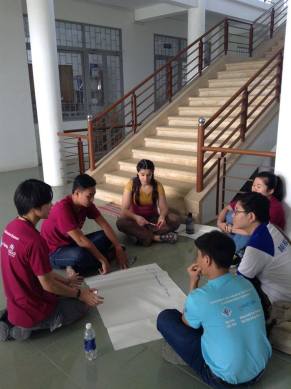 one way that Vietnamese culture is deeply rooted in its Asian background, while at the same time has Western influences.
one way that Vietnamese culture is deeply rooted in its Asian background, while at the same time has Western influences.
In addition to the fusion of language traditions, I have noticed a difference in how time is spent. When I first arrived in Vietnam, I noticed that the society here is relatively fast paced, just like in the United States; however, after visiting for one week I realized that this is not always the case. To clarify, people within the States are very strict with their schedule. People have planned meetings or events that are finished in order, XY&Z. However, in Vietnam I noticed that there is more flexibility in time. For instance, people here still have meetings XY&Z, but meetings XY&Z can be move around, shift to the evening, or even moved to the night or next day. Also, people here have time to sit and enjoy a tea or coffee break in between each meeting. When I observe the lifestyle here, even though people lead very busy lives, they still find a way to allow for flexibility in their schedule and slow the pace of time. In the United States, time moves very quickly and people need to get from point A to point B without any breaks; time is shortened and allowing for flexibility is relatively difficult. In essence, comparing the unique time differences between the two societies is an interesting personal experience for me.
Even though living in the United States, as Americans, we pride ourselves on being multi cultural; in reality this often is not the case. The main language in the States is English, and Americans are not very sensitive to what happens in other  countries except their own, and at times we are very vain about our actions, always seeking for self-improvement. These actions are not necessarily bad, they are just part of American culture. Vietnam runs on a different culture base, which reflects on family values, honor, respect and harmony.
countries except their own, and at times we are very vain about our actions, always seeking for self-improvement. These actions are not necessarily bad, they are just part of American culture. Vietnam runs on a different culture base, which reflects on family values, honor, respect and harmony.
Personally, learning more about Vietnam has helped me to reflect on how I grew up in the States developing distinct individualist actions. While I continue my journey in Vietnam I would like to someday “harmonize” my two worlds, Chinese and American. I’m not exactly sure what this might look like, but after only a week, I can see that I have more to the learn about myself and the world around me.
Turning Waste to Energy
By Saydrah Mallak
Today we had a chance to visit some farms in a rural village outside Can Tho. This is the most fertile part of the Mekong Delta. It was remarkable to see how much each household could produce in their small backyard. In just one hectare, we saw pigs, chicken, fish, and an abundance of vegetables and fruit trees.
 Living in Missoula, Montana, as a student I often wish I could live more sustainably. I try to by using my bicycle to commute, composting and gardening, raising chickens and recycling. I do this because it’s better for the environment, contributes to long-term health benefits, and saves money. Here in Vietnam the farmer’s have created a system that promotes production while also protecting the environment. The farmers use pig manure for plant and fish food, while leftover vegetables are fed to livestock and fish.
Living in Missoula, Montana, as a student I often wish I could live more sustainably. I try to by using my bicycle to commute, composting and gardening, raising chickens and recycling. I do this because it’s better for the environment, contributes to long-term health benefits, and saves money. Here in Vietnam the farmer’s have created a system that promotes production while also protecting the environment. The farmers use pig manure for plant and fish food, while leftover vegetables are fed to livestock and fish.
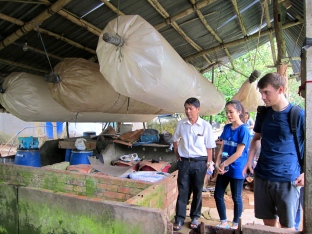 This system is called VACB, which, in Vietnamese, stands for garden, aquaculture, pigs, and biogas. Manure produced by the pigs is channeled into a big bag, called the digester, where it’s turned into biogas. The biogas is funneled to the house to run the stove for cooking and provides electricity. After the manure is decomposed, the left over solids are used to fertilize the garden, while the left over liquid is emptied into the fishpond where it serves two purposes. The first is to promote the growth of essential phytoplankton to feed the new fish the farmer is growing. The second is for growing plants in the pond that can be used for biogas.
This system is called VACB, which, in Vietnamese, stands for garden, aquaculture, pigs, and biogas. Manure produced by the pigs is channeled into a big bag, called the digester, where it’s turned into biogas. The biogas is funneled to the house to run the stove for cooking and provides electricity. After the manure is decomposed, the left over solids are used to fertilize the garden, while the left over liquid is emptied into the fishpond where it serves two purposes. The first is to promote the growth of essential phytoplankton to feed the new fish the farmer is growing. The second is for growing plants in the pond that can be used for biogas.
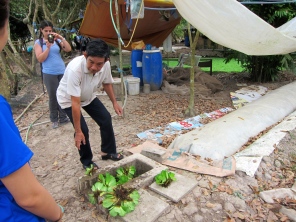 The advantage of this system is that it helps to increase the farmer’s production, supporting their livelihood, while also protecting the environment. The energy source is renewable, reducing the use gas for cooking and lighting, and making life easier for women, requiring less labor for firewood collection.
The advantage of this system is that it helps to increase the farmer’s production, supporting their livelihood, while also protecting the environment. The energy source is renewable, reducing the use gas for cooking and lighting, and making life easier for women, requiring less labor for firewood collection.
We learn about an interesting funding mechanism for these projects by Dr. Chiem. Materials for this system cost $100 to get started. This might sound inexpensive to some, but in a country where the average income is around $2,000 per year, this upfront cost is not insignificant. Funding comes from the Japan International Research Center for Agricultural Sciences (JIRCAS), who works in partnership with Can Tho University (CTU). I t is part of a Clean Mechanism Development project, one that transfers wealth from the developed world to developing countries to invest in emissions-reduction projects. By capturing the methane from animal waste and using it for cooking and lighting, each biogas container can reduce about three tons of carbon dioxide a year (which, interestingly, is about what each of us emitted traveling round-trip to study in Vietnam).
t is part of a Clean Mechanism Development project, one that transfers wealth from the developed world to developing countries to invest in emissions-reduction projects. By capturing the methane from animal waste and using it for cooking and lighting, each biogas container can reduce about three tons of carbon dioxide a year (which, interestingly, is about what each of us emitted traveling round-trip to study in Vietnam).
We meet the farmer in village, Le Hoang Thang, who takes responsibility to train people in how to maintain and fix the systems. I have so much respect for him and for Dr. Chiem. Their passion for protecting the environment is inspiring and gives me hope. Simple strategies like t his can make a difference in terms of improving farmers’ livelihoods and also reducing greenhouse gas emissions. With greater investment from the developed world, carbon credits could pay for even more biogas digesters for farmers across the Mekong Delta and around the world.
his can make a difference in terms of improving farmers’ livelihoods and also reducing greenhouse gas emissions. With greater investment from the developed world, carbon credits could pay for even more biogas digesters for farmers across the Mekong Delta and around the world.
In a few days we will travel to Ca Mau and meet the family of our teaching assistants, Dua and Dinh, whose family grows shrimp, fish, fruit, ducks, and crocodiles. Dinh is studying environmental engineering at Can Tho University and tells me she would like to see if her family might benefit from a biogas digester. She wants to be like Le Hoang Thang, who trains others in the village. We fantasize about if maybe the University of Montana could invest some of its carbon offset money to help support a pilot project. I am inspired and touched by Dinh’s passion, and while I don’t know what it would take to make this possible, I’m keen to try.
Five Things I Was Surprised to Learn About the Vietnam War
By Kelsie Crippen
There is one word that often comes to many American’s mind when they think about Vietnam, and that is war. The Vietnam War, or to some Vietnamese, the War of American Aggression, is a nasty blemish in American history. The war was fought between the communist regime in North Vietnam, and South Vietnam, backed by the United States. Over three million people died in the war, an overwhelming majority of them Vietnamese soldiers, and two million Vietnamese civilians. The United States lost around 58,000 people in the conflict, making it one of the most deadly wars in American history.
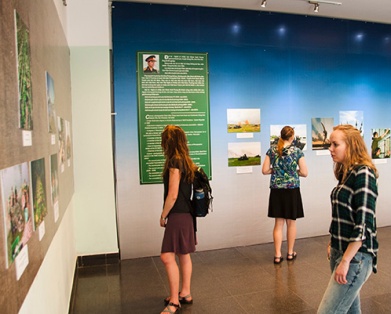 After traveling to Ho Chi Minh City and visiting the War Remnants Museum myself, I recognized how little I actually understood about the struggle and the hardships faced by the Vietnamese people during the war. The Vietnam War is one of the most misunderstood events in American history. War is always ugly, and is destructive to people and their environment around them. In my studies of the war in the past, and my experience at the War Remnants museum, here are some basic yet surprising things I have learned about the Vietnam War:
After traveling to Ho Chi Minh City and visiting the War Remnants Museum myself, I recognized how little I actually understood about the struggle and the hardships faced by the Vietnamese people during the war. The Vietnam War is one of the most misunderstood events in American history. War is always ugly, and is destructive to people and their environment around them. In my studies of the war in the past, and my experience at the War Remnants museum, here are some basic yet surprising things I have learned about the Vietnam War:
1. Kent State:
Although the United States never officially declared war with Vietnam, unofficially it is the longest war in American history and lasted almost 20 years. The American public built up strong opposition during this time and demonstrations were frequent, especially on college campuses. On May 4, 1970, a rally was scheduled at Kent State near the ROTC building on campus. The National Guard told students to disperse, and when students refused, the Guard attempted to end the rally using tear gas. It was a windy day, and the gas was un successful in ending the demonstration. The National Guard then opened fire on the students, killing four and wounding nine. A couple of the students who were shot were not even involved in the protest and were only walking to and from class. This became known as the Kent State Massacre.
successful in ending the demonstration. The National Guard then opened fire on the students, killing four and wounding nine. A couple of the students who were shot were not even involved in the protest and were only walking to and from class. This became known as the Kent State Massacre.
2. Operation Ranch Hand:
When it was clear that traditional warfare was failing in Vietnam, the United States resorted to the use of chemical weapons. During “Operation Ranch Hand,” the United States dropped a chemical called Dioxin, or “Agent Orange,” which is deadly to both humans and the environment. While I was aware of the events surrounding the use of Agent Orange prior my visit to the War Remnants Museum, I never truly grasped just how devastating the effects of the chemical was to Vietnam. It destroyed entire forests, fields and crops, contaminated important water supplies, and upset the delicate ecological balance of central and southern Vietnam. Later, it was discovered that the chemical has intense hereditary effects on second and even third generations of those who have been exposed. Children in Vietnam have suffered greatly, and this suffering is on display to see at the War Remnants Museum. Stuck in my memory is Ngyen Thi Men, a 21 year old who has lived the majority of her![image[1]](https://umvietnamstudy.files.wordpress.com/2015/01/image1.jpg?w=282&h=372) life in a cage-like enclosure because she was born with brain damage and attempts to bite and swallow everything within her grasp. Walking through the museum and seeing picture after picture of children suffering from the effects of Agent Orange, generations after their family members were exposed, was a chilling and emotional
life in a cage-like enclosure because she was born with brain damage and attempts to bite and swallow everything within her grasp. Walking through the museum and seeing picture after picture of children suffering from the effects of Agent Orange, generations after their family members were exposed, was a chilling and emotional
3. The Draft and the Civil Rights Movement:
The Vietnam War coincided with the Civil Rights Movement, and the two are connected in very specific ways. African American war veterans who served in Vietnam returned home to a place where they were denied the same rights as whites, and where they were treated as second-class citizens. Groups like the National Association for the Advancement of Colored People became associated with communism, causing them to lose support. The Draft itself was specifically discriminatory towards African Americans for a couple of reasons. Draft Boards in Alabama, Arkansas, Mississippi, and Alabama did not have a single African American voice, and KKK leader Jack Helms was a member of the Louisiana Board. Although every male was required to register for selective service on their 18th birthday, there were several loopholes for draft deferment during the Vietnam War. First, if an employer claimed that someone’s work was critical to their business, they were often not required to serve in the military. Men enrolled in college were also given draft exemptions. Deferment rules may very well had good intentions behind them, but they certainly ended up disproportionately effecting minority groups.
4. Vietnam War Crimes:
When I think of war crimes, I usually think of Nazi Germany. The War Remnants Museum reminded me that war crimes have occurred in other wars, and the United States is guilty of atrocities as well. It was a chilling experience witnessing the same small tiger cages, which held three or four Vietnamese soldiers, or to see photos of civilians who had their teeth removed for refusing to share information with the United States backed South. These crimes were not only inhumane and cruel, they endanger the foundation of America itself. A powerful reminder of this at the War Remnants Museum was a placard of the opening lines of the Declaration of Independence. “We hold these truths t![image[2]](https://umvietnamstudy.files.wordpress.com/2015/01/image2.jpg?w=214&h=281) o be self-evident, that all men are created equal, that they are endowed by their creator with certain unalienable Rights, among these are Life, Liberty, and the Pursuit of Happiness…”
o be self-evident, that all men are created equal, that they are endowed by their creator with certain unalienable Rights, among these are Life, Liberty, and the Pursuit of Happiness…”
5. Vietnam is Much More than the Location of a War:
After the war, Vietnam normalized relations with the United States in 1995 and the two have since become important trading allies. It is difficult to fathom a U.S.-Vietnamese friendship after the atrocities mentioned above, but I am certainly glad for peace between us because it has given me the opportunity to travel here. Vietnam is a country of beautiful scenery, excellent food, and graceful people. Since my arrival I have felt safe and welcome. The Vietnamese are quick to greet you with a smile and a nod hello. After my visit to the War Remnants Museum, I am not sure Americans deserve such a polite reception, but the people here like to look forward to a bright future rather than dwelling on the past. I am looking forward to contributing to a bright future, as tomorrow we will travel to Can Gio, a mangrove forest restoration site. Agent Orange destroyed over half of the mang rove trees in the Delta area, and I am lucky to have the opportunity to actually plant mangroves, which over time will hopefully help restore the area to its natural condition.
rove trees in the Delta area, and I am lucky to have the opportunity to actually plant mangroves, which over time will hopefully help restore the area to its natural condition.
Environmental Concern Transcends Language
By Blayne Metz
“I, you, love environment,” they say. It might not be proper English, but as I reach my right hand across my left shoulder and my left across my right to complete hearts with impassioned Vietnamese students, the message cannot be more clear. They love the environment.
 We’ve just finished short presentations and group activities with Love Environment, an active environmental group here on the Nong Lam campus in Ho Chi Minh City. They do a variety of projects including public awareness and educational seminars. The most inspiring thing about them is that it is completely voluntary and all projects they engage in are funded entirely through donation or are self-funded. We share about our environmental initiatives: my work with ASUM and MontPIRG, Mara’s at the FLAT, Shannon with WEN, and Hannah’s at Free Cycles.
We’ve just finished short presentations and group activities with Love Environment, an active environmental group here on the Nong Lam campus in Ho Chi Minh City. They do a variety of projects including public awareness and educational seminars. The most inspiring thing about them is that it is completely voluntary and all projects they engage in are funded entirely through donation or are self-funded. We share about our environmental initiatives: my work with ASUM and MontPIRG, Mara’s at the FLAT, Shannon with WEN, and Hannah’s at Free Cycles. 
The energy in the air is unmistakable. We are all excited to share our experiences and knowledge. After the presentations, we break into small groups to talk about the environmental issues that concern us, the barriers we face in working on them, and ways we might be able to support one another. Much to my dismay, they do not speak much English and our group-work is only possible through a semi-fluent translator who’s chosen the English name of Radiant Sun. We quickly become friends. They apologize for not knowing English and are visibly embarrassed, but I am the embarrassed one for not knowing but a handful of words in Vietnamese. I truly wish I could speak the language. We are lucky that English is the mother tongue.
We all have different specific interests and different passions. Their passions come largely from the changes in climate that are occurring here in Vietnam where (among other problems) rising tides, rapid urbanization, heavy pesticide use and pollution are impacting the quality of life. Our passions come from similar concerns, with climate change and pollution, but the problems they face are, to a large degree, facilitated by my country as one of the largest producers of C02. I have seen many of the issues they speak of in Vietnam first hand – I’ve seen the smog, the incessant rush of urban traffic, the metrics of rising tides and their potential impacts on this beautiful country. I feel a tinge of guilt. Yet they understand what many countries have yet to accept and embrace: global cooperation is essential if we are to find solutions to these pressing issues.
After taking group pictures we take a tour of the campus before engaging in some group games. Their laughter and spirit are infectious. Inevitably, we must leave these gracious hosts and they are sad to see us go. We are on the road to Can Tho.
In Can Tho we have another exchange, this time with students from the Delta Youth Alliance at Can Tho University. We engage in the same activities as before, but their English skills are better. One of our students takes a particularly long time during an explanation and I happen to catch one Vietnamese student jokingly say “thank you for your speech.” I fight to stifle my laughter. This suggests a very good understanding of the English language, and I am impressed. The day that I can make jokes in Vietnamese is far off indeed. Some day perhaps. These students are equally excited to share their knowledge and projects. We learn about the “floating toilet,” a project that composts and cleans bathroom waste while providing a modern amenity to river-dwelling Vietnamese. This demographic constitutes a large percentage of the Vietnam population and is thus a very smart project.
We finish the day with some sports – soccer first and then volleyball – a nice way to lighten the mood after diving into some of the heaviest topics of the modern day. But I can’t detach myself from these topics. They weigh heavy on me as we depart for the day and head back to the hotel. I look forward to the day when I can fight for changes in the world. I take solace in the fact that I am making connections with individuals who will be my future brothers (and sisters) in arms.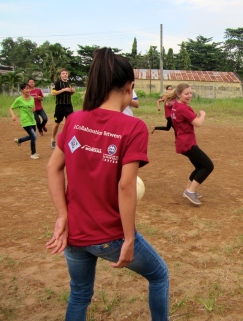
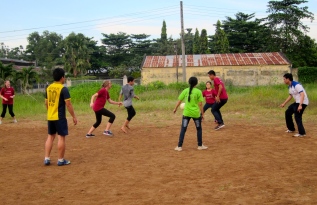
**Photos by Shanti Johnson and Nicky Phear.



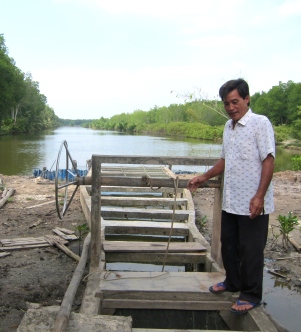
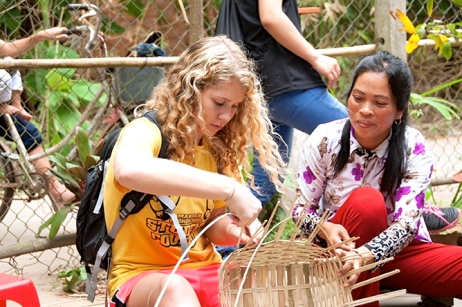
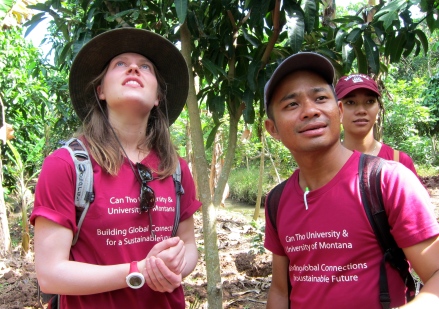


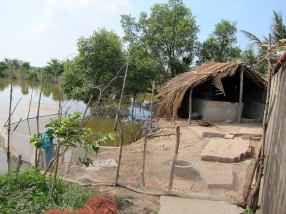
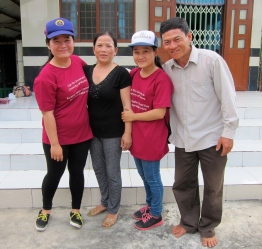





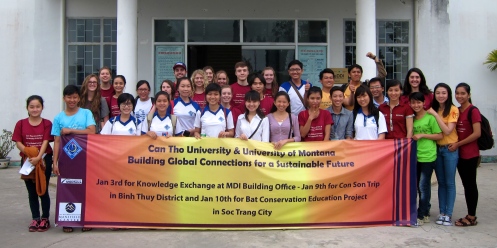


You must be logged in to post a comment.